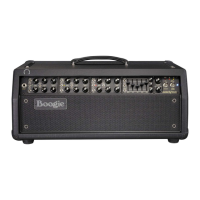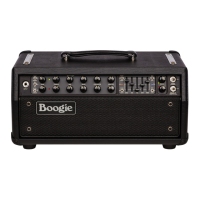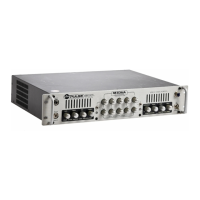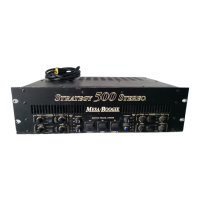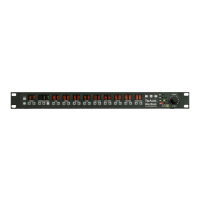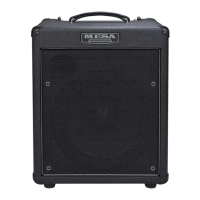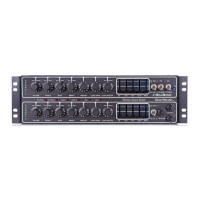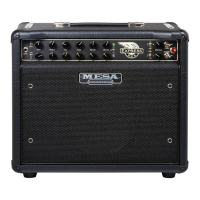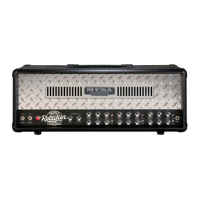PAGE 17
Fire and focus, ferocious yet singing, these are the traits that made the IIC+ the legendary amp it is. Being a bit
more “stripped” and raw, it also sits in a track well, and the more complex the track is, the better. It has a mid-
focused attack that defines its character while also being harmonically rich in the top end.
Most players using it for Heavy sounds scoop some of this midrange out of the mix with the 5-Band EQ while
also enhancing the two lowest and two highest Sliders in the classic “V” curve. However, even when the inher-
ent mid focus is reduced with this classic EQ curve, the nature of the circuit itself keeps the sound aggressive,
urgent, percussive, and tight. Some of rock and metal’s most iconic songs and albums feature the IIC+, and we
feel, as do those we shared this version with early on, it’s all IIC+ and then some!
MARK IV
We finish o Channel 3 with another legendary MARK amplifier Mode, the mighty MARK IV. We included this
thick, creamy gain mode in the VII’s predecessor, the MARK FIVE, and it soon became many players’ go-to for
instantly friendly Lead sounds due to its wider, thicker, throaty voice and easy to play feel.
MARK IV has more low end in its makeup and produces a more three-dimensional version of the classic IIC+
sound. It excels at single note solos and melody work, adding girth and depth to your phrases. It also produces
huge Crunch Rhythm sounds and can be even “heavier sounding” than the IIC+ sound due to this added low
end girth and thicker gain signature.
And don’t underestimate the MARK IV for lower to medium gain work as well. Its added low end and smoother
top make lower gain solo, and even chording, sounds breathe and have an ambiance all its own, yet leans a
bit toward traditional. The overdrive smears nicely across the spectrum and, with the right Treble and Presence
settings, can even become a nice semi-clean threshold sound with your guitar volume backed o a bit.
There are few amps that oer the flexibility of even ONE of the MARK VII’s three wildly versatile Channels, let
alone contain the collection of powerful Modes in these three riding alongside each other here. Serious Tone
Power awaiting your thoughtful dedication in the seven performance Modes means the MARK VII truly stands
alone in terms of musical readiness and near-limitless versatility where analog and real are the guiding direc-
tives and the result.
Adding the shaping power and flexibility of the Five Band Graphic EQ expands these Mode choices and their
authenticity manyfold to arrive at the most comprehensive Tone palette for guitar found anywhere in the analog
domain. Combine that with the dierent responses and sounds of various speakers and cabinet styles, or in the
World of DI, the Channel Assignable IR options, and you’ve got an ultimate Tone Tool that won’t go out of style
or need software upgrades to keep providing you with musical value and great Tone for many years to come.
THE CONTROLS
The MARK SEVEN’s GAIN and Tone Controls, though tripled due to the Channel count, are simple and straight-
forward. They do the same basic things across all three Channels, though depending on the Mode called up,
they can have setting nuances important to achieving optimum performance. Things like, don’t set the BASS
control too high in Channel 3 when using high GAIN settings. Or avoiding high settings of TREBLE and PRES-
ENCE combined in high gain Modes …especially with the Graphic EQ engaged and the high-end boosted.
These and other control setting nuances will become apparent and second nature to you with some hours in
the driver’s seat and great sounds achieved, so not to worry, it’s mostly common sense. That said, it is worth
the time experimenting to learn how the Controls interact to achieve the things you want to hear and feel.
The GRAPHIC EQ is its own entity, and since it is at the rear end of the signal path, interaction with the rotary
TONE Controls located earlier in the preamp is somewhat diminished. That’s not to say it isn’t powerful, though,
as the opposite is true. In many cases, the 5 Band Graphic EQ will be your most powerful shaping tool, espe-
cially in terms of tight low end in Channel 3, where too much low end earlier in the preamp can compromise
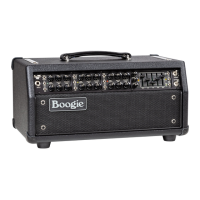
